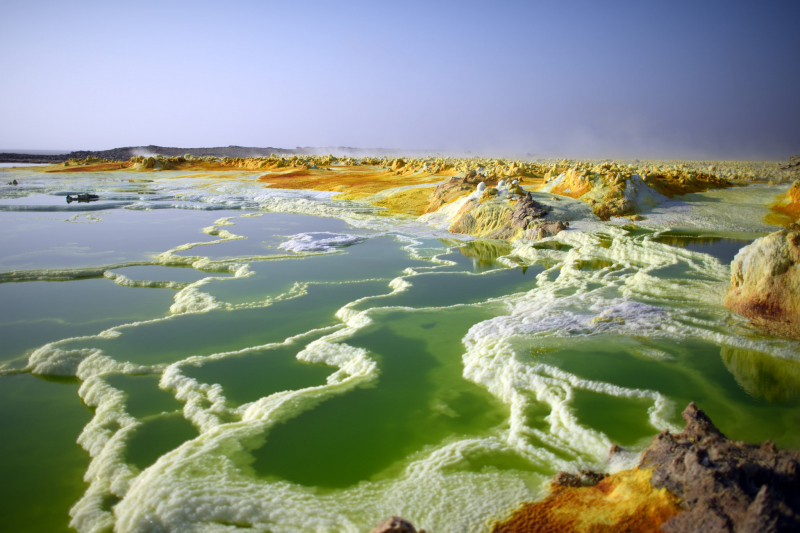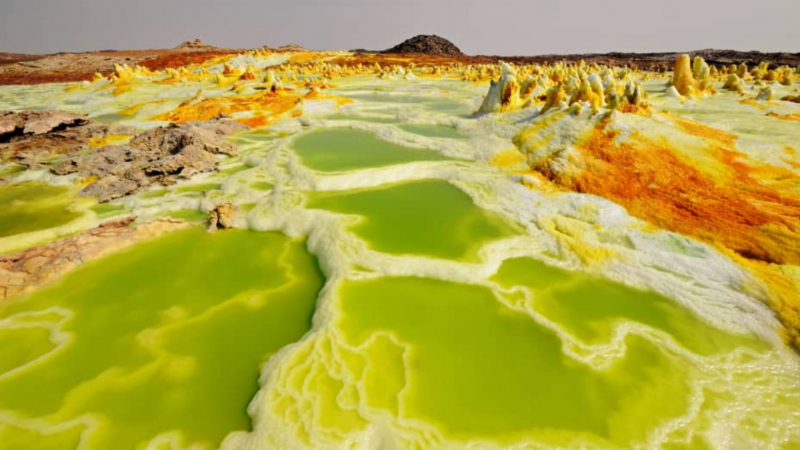Danakil Depression, Ethiopia
One of the strangest places on earth, it has been referred to as a "gateway to hell" and a true "land of death." The Danakil Depression's sulfurous hot springs, acid pools, steaming fissures, and salt mountains look like they belong in a science fiction film. But the location is real, and it's a popular tourist destination in Ethiopia. The Danakil Depression draws salt miners, scientists, and travelers. It is one of the hottest places on Earth (by average daily temperature) as well as one of the lowest (more than 400 feet below sea level). Miners travel hours, often by camel caravan, to extract salt slabs from the flat pans around Lake Afar, as they have for centuries. Salt is the region's "white gold," and it was used as money in Ethiopia until the twentieth century.
Visitors are drawn to the Danakil Depression for a completely different reason. It's a hot, foul-smelling, punishing place, which is why people travel across continents to see it. Despite its difficulty, those who make the journey rave about it. Dallol's sulfur springs are particularly appealing, with their stupefying shades of neon green and yellow that hiss forth from the rocky terrain. Erta Ale (meaning "Smoking Mountain" in the local Afar language) is another, with its cartoon-like molten center and one of only eight lava lakes in the world.
Danakil is located in the Afar Triangle, a geological depression in Ethiopia's remote northeastern region where three tectonic plates are slowly diverging. The area is large (124 miles by 31 miles) and used to be part of the Red Sea. Volcanic eruptions emitted enough lava overtime to seal off an inland sea, which evaporated due to the arid climate.
It's scorching outside. Daily temperatures average around 94 degrees Fahrenheit (34.4 degrees Celsius) but can reach as high as 122 degrees Fahrenheit (50 degrees Celsius), and rainfall is scarce. Day trips departing from Wikro typically begin around 4 a.m. From there, a four-wheel drive convoy begins a three-hour journey across the Ethiopian portion of the Great Rift Valley on a winding mountain road. For a faster route, helicopter rides are also available.
Travelers from all over the world have long been inspired by nature's changing hues, from autumn foliage excursions to cherry blossom season. But what really strikes me about this place is the variety of natural colors, set against a vast expanse of nothing. The rain and seawater from the nearby coasts seep into the sulfuric lakes where they are heated by the magma, resulting in a mixture of yellow, orange, red, blue, and green. These brilliant colors start to appear as the sea salt reacts with the minerals in the magma. As the water evaporates in the heat, colorful crust-like deposits from all over the place and mysteriously blend with the depression's turquoise lakes, which are cooler.
The high season in the Danakil Depression lasts from November to March, when temperatures, though still in the 90s F, are slightly more bearable. From June to August, the weather is described as "unsuitable," and tours are still available, but the experience is often more arduous than pleasurable. It truly is one of the most alien places on the planet. It is one of the planet's most remote, unlivable, hottest, and lowest points. Sounds a little scary, but that's what makes it so intriguing.
Location: Afar Triangle, Ethiopia

















